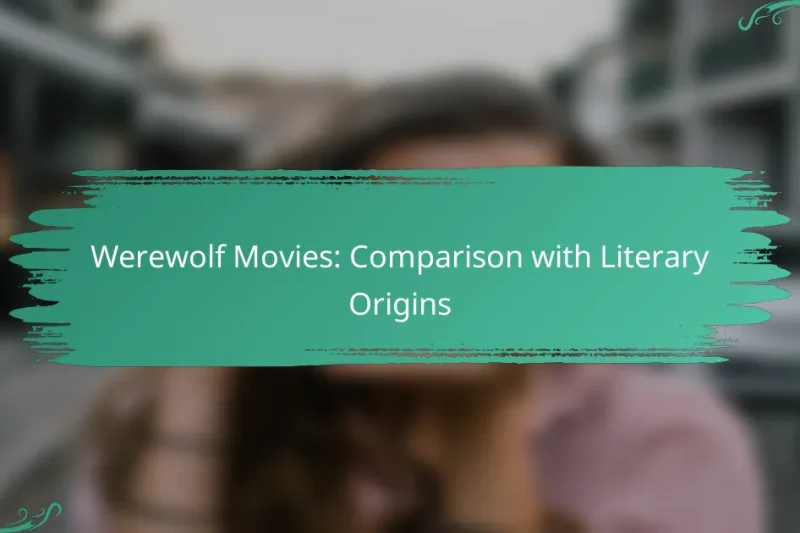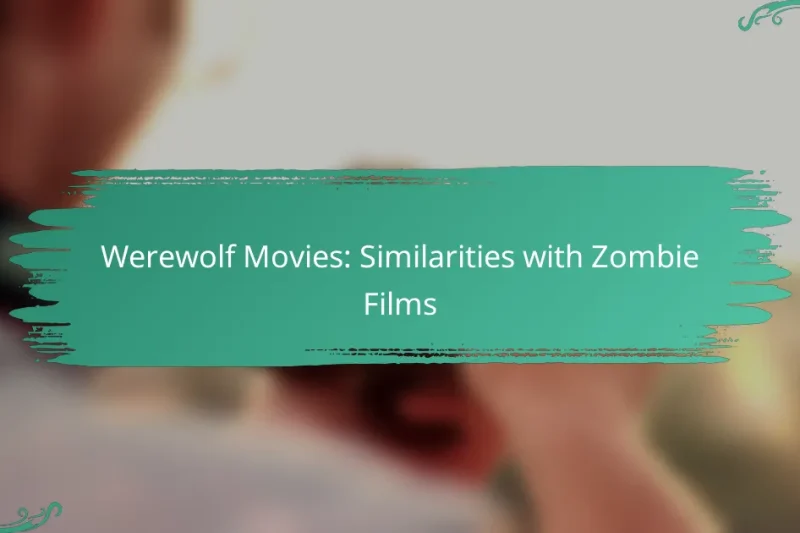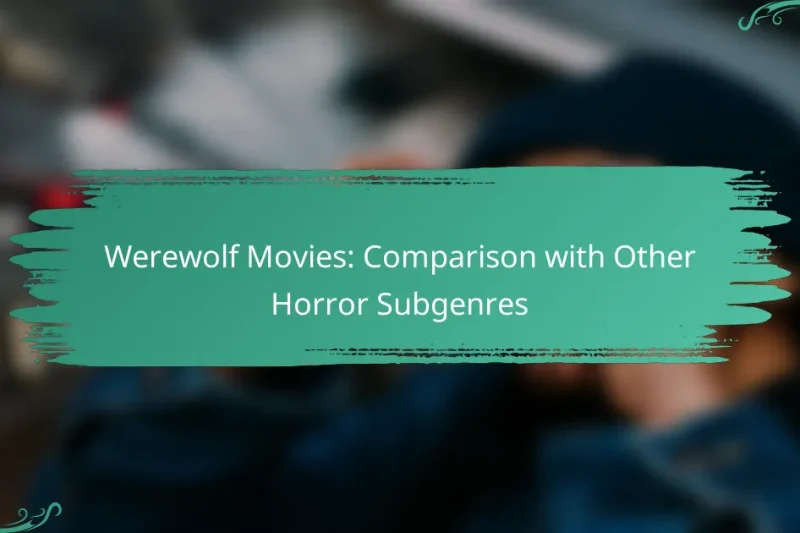Werewolf movies frequently draw from their literary origins, adapting core themes and character arcs while infusing … Werewolf Movies: Comparison with Literary OriginsRead more
Werewolf Movie Comparisons
Werewolf movies have captivated audiences by intertwining horror, dark humor, and compelling narratives. From the iconic “American Werewolf in London” to cult favorites like “Ginger Snaps,” these films explore themes of transformation and isolation, resonating with viewers on a deeper level. Their varying box office performances highlight the impact of production choices and audience reception within this unique genre.
Werewolf Movies: Best Compared to Vampire Films
When comparing werewolf movies to vampire films, distinct storytelling styles and thematic elements emerge, showcasing the … Werewolf Movies: Best Compared to Vampire FilmsRead more
Werewolf Movies: Similarities with Zombie Films
Werewolf movies and zombie films exhibit striking similarities, particularly in their exploration of transformation, survival, and … Werewolf Movies: Similarities with Zombie FilmsRead more
Werewolf Movies: Borrowing Elements from Sci-Fi
Werewolf movies frequently intertwine traditional horror with science fiction, introducing advanced technology and speculative themes that … Werewolf Movies: Borrowing Elements from Sci-FiRead more
Werewolf Movies: Comparison with Other Horror Subgenres
Werewolf movies stand out in the horror genre by delving into themes of transformation and the … Werewolf Movies: Comparison with Other Horror SubgenresRead more
Which werewolf movies are the most popular?
The most popular werewolf movies often blend horror with dark humor and compelling storytelling. Classics like “American Werewolf in London” and “The Howling” have set benchmarks in the genre, while newer films like “Ginger Snaps” and “Dog Soldiers” have gained cult followings.
American Werewolf in London
<p"American Werewolf in London" is a landmark film that combines horror and comedy, released in the early 1980s. It is renowned for its groundbreaking special effects, particularly the transformation scene, which remains iconic in cinema history.
The film follows two American backpackers who encounter a werewolf in the English countryside. Its blend of humor, horror, and memorable characters has made it a staple in werewolf cinema.
The Howling
“The Howling,” released in the same era as “American Werewolf in London,” offers a more serious take on werewolf lore. It focuses on a television reporter who seeks refuge in a remote commune, only to discover its dark secret.
This film is notable for its atmospheric tension and strong performances, as well as its exploration of the werewolf mythos. It has influenced many subsequent films in the genre.
Ginger Snaps
“Ginger Snaps” presents a unique perspective on werewolves by intertwining themes of adolescence and female empowerment. The film follows two sisters, one of whom transforms into a werewolf after a mysterious attack.
This Canadian film is praised for its clever writing and character development, making it a favorite among horror enthusiasts. Its metaphorical approach to puberty and transformation resonates with many viewers.
Dog Soldiers
“Dog Soldiers” is a British film that combines military action with horror elements. It follows a group of soldiers on a training mission in the Scottish Highlands who encounter a pack of werewolves.
The film is known for its intense action sequences and practical effects, creating a gripping atmosphere. It has garnered a loyal fanbase for its blend of humor and horror, as well as its unique setting.
Wolfman
The 2010 remake of “Wolfman” brings a modern twist to the classic Universal monster tale. Starring Benicio del Toro, it explores themes of family and legacy while delivering a visually stunning experience.
This film pays homage to the original while incorporating contemporary special effects and a darker tone. Its gothic atmosphere and strong performances have made it a notable entry in the werewolf genre.
How do werewolf movies compare in terms of box office performance?
Werewolf movies vary significantly in box office performance, often reflecting their production budgets, marketing strategies, and audience reception. Iconic films like “American Werewolf in London” have achieved notable success, while others have performed modestly.
American Werewolf in London earnings
“American Werewolf in London” is considered a classic in the werewolf genre, grossing approximately $30 million in the United States during its initial release in the early 1980s. Its blend of horror and dark comedy, along with groundbreaking special effects, contributed to its strong box office performance.
The film’s success has led to a lasting legacy, influencing numerous werewolf films and maintaining a steady audience through home video and streaming platforms. Its earnings reflect the potential for werewolf movies to achieve significant financial success when they resonate with audiences.
The Howling earnings
<p"The Howling," released around the same time as "American Werewolf in London," earned roughly $17 million in the U.S. box office. This film is notable for its more serious tone and innovative transformation scenes, which appealed to a different segment of horror fans.
While its earnings were lower than its counterpart, “The Howling” established itself as a cult favorite, demonstrating that even films with modest box office returns can maintain a dedicated following and influence future productions in the genre.
Ginger Snaps earnings
“Ginger Snaps,” a more contemporary take on the werewolf theme, had a limited release and grossed around $1 million in the U.S. box office. Despite its low earnings, the film gained critical acclaim and a strong fan base, particularly among younger audiences.
The film’s unique approach to the werewolf mythos, focusing on themes of adolescence and transformation, showcases how innovative storytelling can resonate with viewers, even if box office performance does not reflect widespread commercial success.
What are the key themes in werewolf movies?
Werewolf movies often explore themes of transformation, isolation, and fear of the unknown. These themes reflect deeper human experiences and societal anxieties, making them resonate with audiences across different cultures.
Transformation and identity
Transformation is a central theme in werewolf films, symbolizing the struggle between one’s human nature and primal instincts. This duality often leads to a crisis of identity, where characters grapple with their new reality and the consequences of their actions.
For instance, a character may initially embrace their werewolf form for power or freedom but later confront the darker aspects of their transformation. This internal conflict highlights the tension between societal expectations and personal desires.
Isolation and community
Isolation is frequently depicted in werewolf narratives, where the protagonist feels alienated from society due to their condition. This sense of being an outsider can lead to a longing for connection, often resulting in tragic outcomes.
Conversely, some films explore the dynamics of community among werewolves, showcasing how they form bonds and support systems. This duality emphasizes the importance of belonging while also highlighting the risks of exclusion from human society.
Fear of the unknown
Fear of the unknown is a pervasive theme in werewolf movies, reflecting humanity’s anxiety about what lies beyond the familiar. This fear can manifest in the characters’ reactions to their transformations and the unpredictability of their actions.
Additionally, the werewolf itself often represents the primal fears lurking within, such as violence and loss of control. This theme resonates with audiences, as it taps into universal fears about the darker aspects of human nature and the unpredictability of life.
How do werewolf movies differ by decade?
Werewolf movies have evolved significantly over the decades, reflecting changes in societal fears, filmmaking technology, and audience expectations. Each decade showcases distinct themes, styles, and character portrayals that highlight the cultural context of the time.
1970s werewolf films
The 1970s marked a turning point for werewolf films, introducing a blend of horror and social commentary. Movies like “The Howling” and “An American Werewolf in London” explored themes of identity and transformation, often using the werewolf as a metaphor for societal issues.
Special effects began to play a crucial role, with practical effects and makeup techniques creating more realistic transformations. This decade set the stage for a more visceral and psychological approach to the werewolf mythos.
1980s werewolf films
In the 1980s, werewolf films embraced a more campy and humorous tone, with titles like “Teen Wolf” and “The Howling II” blending comedy with horror. This era saw a rise in popularity for werewolf comedies, appealing to a younger audience and reflecting the decade’s pop culture.
Special effects technology advanced further, allowing for more elaborate transformations and creature designs. The 1980s also introduced a more stylized aesthetic, often featuring vibrant colors and energetic soundtracks that contributed to the films’ entertainment value.
2000s werewolf films
The 2000s brought a resurgence of serious werewolf narratives, with films like “Dog Soldiers” and “Underworld” focusing on darker themes and complex lore. This decade saw a blending of genres, incorporating elements of action and fantasy into the traditional horror framework.
Digital effects began to supplement practical effects, enhancing the visual experience while maintaining a gritty realism. The portrayal of werewolves shifted to more nuanced characters, often exploring their struggles with morality and humanity.
What are the best werewolf movie remakes?
Some of the best werewolf movie remakes include films that successfully blend horror with compelling storytelling. Notable examples often feature updated special effects, modern themes, and fresh takes on classic narratives.
The Wolfman (2010)
The Wolfman (2010) is a remake of the 1941 classic, featuring Benicio del Toro as Lawrence Talbot, a man who returns to his ancestral home only to be bitten by a werewolf. This film emphasizes a darker, more gothic atmosphere, with impressive visual effects that bring the transformation scenes to life.
Critics noted that while the film aimed for a blend of horror and drama, it struggled with pacing and character development. However, the performances, particularly by Anthony Hopkins and Emily Blunt, added depth to the story.
When watching The Wolfman, pay attention to the cinematography and sound design, which enhance the eerie mood. The film’s blend of practical effects and CGI offers a unique viewing experience, making it a worthwhile remake for horror enthusiasts.




